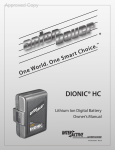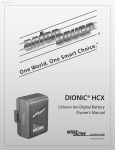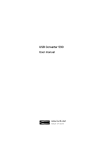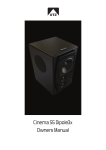Download Atomic Aquatics Safe Second Inflator Specifications
Transcript
TECHNICAL TRAINING SS1 2003 •1 Limited Lifetime Warranty Atomic Aquatics warrants the SS1 safe second/inflator against defects in materials and workmanship for the lifetime of the original original owner with the exception of mouthpieces, hoses, orings, or valve o seats, which are warranted for 2 years Atomic Aquatics will at its option repair or replace any components components it finds defective. This warranty does not cover regulators purchased from other than than authorized Atomic Aquatics dealers, or regulators purchased via Internet or mail order sources. To activate this warranty you must must complete and return the warranty registration card within 30 days days of purchase. All titanium or stainless steel components are warranted for the lifetime of the original owner against the effects of corrosion. Chromed or plated brass components are subject to corrosion and require as a minimum reasonable maintenance fresh water rinsing after use in salt water and proper storage as described in the owners owners manual. Without going into great detail, the warranty is a two year or 1 year warranty dependent upon model, which will cover parts and labor. At the 1 year or 2 year mark has passed the warranty will stay in effect for the lifetime of the original owner with an exception of wearable parts. Our warranty differs in that we will not void a warranty if a regulator is not factory serviced each year. Our company policy also prohibits mail order and internet sales and will void the warranty if such a sale occurs. •2 Limited Lifetime Warranty This warranty is not contingent upon proof of service and will maintain in effect for the lifetime of the original owner. It is recommended however that maintenance include an annual safety inspection to be performed by an authorized Atomic Aquatics dealer dealer or by the factory. Factory or authorized dealer servicing is required required at intervals of 300 dive hours or 2 years, whichever occurs first. This service will include disassembly, cleaning, replacement and lubrication of all oo-rings and seals, and safety check. To obtain warranty service, you must deliver the SS1 to Atomic Aquatics or one of its authorized repair facilities. If you send the SS1 to the factory, you must pay the shipping charges to the factory. factory. If the regulator is returned to the factory and it is determined that that the problem is due to material or manufacturing defect, there will be be no charge for parts, labor or return shipping within the continental continental US. This warranty does not cover damage or defect due to neglect, misuse, alteration, or attempted repairs by someone other than an an authorized dealer. Without going into great detail, the warranty is a two year or 1 year warranty dependent upon model, which will cover parts and labor. At the 1 year or 2 year mark has passed the warranty will stay in effect for the lifetime of the original owner with an exception of wearable parts. Our warranty differs in that we will not void a warranty if a regulator is not factory serviced each year. Our company policy also prohibits mail order and internet sales and will void the warranty if such a sale occurs. •3 Service Kit, and O-ring: Replacement ATOMIC AQUATICS REGULATORS ARE TO BE SERVICED ONLY WITH ATOMIC AQUATICS PARTS. THE USE OF OTHER MANUFACTURERS OO-RINGS, AND OR OTHER PARTS CAN LEAD TO MALFUNCTION OF THE EQUIPMENT. TIGHTEN ALL THREADED COMPONENTS TO PROPER TORQUE. TIGHTENING SPECIFATIONS CAN BE FOUND IN THE SCHEMATICS. SCHEMATICS THIS “SERVICE CLINIC” CLINIC” PRESENTATION IS DESIGNED TO SHOW AS MUCH TECHNICAL PROCEDURAL INFORMATION AS POSSIBLE, HOWEVER THERE ARE SOME LIMITATIONS AND WRITTEN PROCEDURES AND SCHEMATICS SHOULD ALWAYS BE REFERRED TO IN CONJUCTION WITH THIS PRESENTAION. For the simplicity of this clinic we will not be replacing o-rings or tightening the regulator components to their proper torque specifications. However I want you to know that the written procedures which are in front of you call out the proper part numbers and torque specifications, and should be used in conjunction with this media when servicing a regulator in the future. •4 Specific Enriched Air (NITROX) Limitations IMPORTANT NOTICE 1. THIS REGULATOR/INFLATOR HAS BEEN ASSEMBLED, CLEANED AND MADE COMPATIBLE FOR ENRICHED AIR NITROX (EAN) TO A MAXIMUM 50% OXYGEN CONCENTRATION AT A MAXIMUM PRESSURE OF 3500 PSI. 2. DO NOT UNDER ANY CIRCUMSTANCES USE THIS REGULATOR WITH PURE OXYGEN OR ANY GAS MIXTURE EXCEEDING 50% OXYGEN. FAILURE TO COMPLY WITH THE ABOVE WARNING COULD CAUSE SERIOUS PERSONAL INJURY OR DEATH FROM FIRE OR EXPLOSION. 3. DO NOT USE SILCONE OR PETROLEUM BASED GREASES OR OILS IN OR AROUND REGULATORS BEING USED FOR NITROX OR (EAN) OXYGEN MIXES. Atomic Aquatics wants to emphasize the importance of cleaning and fallowing the guidelines set out by us as well as other agencies when it comes to diving and safe handling of our equipment around high percentages of Oxygen. We mandate that our regulators not be used with higher percentages of oxygen than 40% and pressures higher than 3500 psi. When a regulator is sent from the factory to a customer, the regulator in its current state is allowed at the pressures stated before. •5 General Notes: Enriched Air (NITROX) Use 1. NEVER PRESSURIZE ATOMIC AQUATICS REGULATORS WITH PURE OXYGEN. 2. EAN MIXTURES MUST MEET ANDI PURITY STANDARDS FOR OXYGEN COMPATIBLE AIR. 3. EAN MIXTURES MUST NOT BE CONTAIMINATED BY COMPRESSED AIR THAT DOES NOT MEET ANDI OXYGEN GAS PURITY STANDARD. 4. EQUIPMENT THAT HAS BEEN CONTAMINATED MUST BE RERE-CLEANED BEFORE USE WITH EAN. 5. CLEANING OF PARTS MUST BE DONE WITH BLUE GOLD OR ANDI APPROVED OXYGEN CLEANING SOLUTION. 6. DURING REGULATOR SERVICING, ONLY ATOMIC AQUATICS FACTORY SUPPLIED OO-RINGS AND SPARE PARTS MAY BE USED. 7. CHRISTOCHRISTO-LUBE MCG 111 OR MCG 129 MUST BE USED FOR LUBRICATION. DO NOT USE SILICONE GREASE IN OR AROUND EAN EQUIPMENT. Atomic Aquatics regulators are never to be used with with pure oxygen and Christo-lube 111, or 129 is to used exclusively as a lubricant weather it is to be used in a Nitrox environment or not. The use of other than factory supplied orings and seals is strictly prohibited and can cause serious damage to the product •6 SS1 Regulator Tools Hex wrencheswrenches- (3/16” (3/16”) Open end wrencheswrenches- (1/2” (1/2”, 5/8” 5/8”, 11/16” 11/16”, and adjustable wrench) Stubby flat bladed screwdriver O-ring pick Nut DriverDriver- (1/4” (1/4”, 5/16” 5/16”) Pliers (Needle Nose) 2nd Stage TT-handle Tool The tools we will be using to disassemble and assemble the regulators today are the 2nd stage t-handle tool which is designed exclusively for our 2nd stage, the piston bullet for installing the piston and other functions as well as the 1st stage thandle wrench used for various procedures on our 1st stage regulators. Some of the other tools that you will need for a standard service are basic shop tools such as the wrenches mentioned on this slide. •7 BCD Adapter Installation Notes Standard 1.0” 1.0” adapter assy. This is the most common size and used on most R R BCD’ BCD’s. Fits most ScubaPro , Zeagle , R R R R Tusa , IDI , Deep Outdoors , Dive Rite , and others. This adapter comes only as an assembly with the adapter sleeve an integral component. Medium adapter 3/4” 3/4” to 13/16” 13/16” hoses. Fits R most Mares . Adapter sleeve must be installed before inserting hose. Small adapter 11/16” 11/16” to 3/4” 3/4” hoses. Fits R smaller diameter Oceanic and US R Divers . Adapter sleeve must be installed before inserting hose. •8 BCD Adapter Installation Notes All adapters are supplied with a cable pull pin. Each pin is a different length to fit the specific adapter. Make certain you use the correct correct pin. The correct pin should be approximately the same length as the diameter of the adapter and not protrude from it when installed. •9 BCD Adapter Installation Notes The adapters must be secured to the hose with at least 1 cable tie tie and we recommend gluing in place with neoprene (wetsuit) cement for added security. Water test all connections for leaks before releasing to the customer. customer. Fully inflate the BCD and test operation of the cable dump system system if installed. The cable dump should not leak when the BCD is fully inflated and should release air when pulled slightly. •10 SS1 DISASSEMBLY •11 Removal of Mouthpiece The serial number is located under the mouthpiece and can be identified by the letter “S” followed by several numbers. Remove the mouthpiece by cutting the cable tie and gently pull back on the mouthpiece. •12 Removal of Front Cover & Diaphragm Position the SS1 on a firm surface with a towel under it to protect protect it. Using a short, flat bladed screwdriver, insert the blade into one one of the elongated slots in the plastic body. Push down firmly to unlock unlock the tabs of the cover retainer. •13 Removal of Front Cover & Diaphragm Repeat to unlock all 4 tabs then withdraw the cover retainer, cover, cover, inner ring and diaphragm. •14 Removal of Inflator Stem Unscrew the inflator cover using the Atomic 2nd Stage tool. Using the short flat bladed screwdriver, unscrew the plastic seal retainer from the plastic body. •15 Removal of Inflator Stem Now depress the inflator button and unscrew the inflator stem from the button. Put the button and spring aside. Push the stem and rubber seal out of the plastic body. •16 Removal of Inflator Stem Using an oo-ring pick, remove the inflation spool from the body. Using an oo-ring pick, remove the inflator cover oo-ring. The inflator stem oo-ring is located inside the body, beneath the inflation spool. Remove it also. •17 Removal of Exhaust Valve Unscrew the plastic exhaust cover. Lift up the edges of the exhaust valve and unscrew the plastic exhaust valve spider. If it is too tight, use the open jaws of a pair of long nosed pliers placed in between the legs of the spider to unscrew it. •18 Removal of Exhaust Valve Seal Remove the thin rubber gasket. Using the 5/16” 5/16” nut driver, unscrew the nut holding the exhaust seal from the exhaust stem. •19 Removal of Deflation Button The button, stem, spring, washer and o-ring are now free from the case. Leave the stem attached to the button. (If the washer and oo-ring do not come free during the last procedure, gently remove them with an oo-ring pick). If the unscrewing the nut happens to unscrew the stem from the button instead, the result will be the same. •20 Removal of Valve Body from the Case Pull back and remove the hard rubber dust protector from the inlet nipple. Using an oo-ring pick, push the CCclip out of its groove and slide it off the nipple. Do not spread it open or you will bend it. •21 Removal of Valve Body from the Case Push the valve body assembly out of the plastic body. •22 Disassembly of Valve Body Using a 1/2” 1/2” open end wrench on the inlet and adjustable wrench on the valve housing, unscrew the inlet from the housing. Be careful not to slip the wrench and damage the wrench flats on the inlet. Hex wrench Push the orifice out of the inlet tube with a 3/16” 3/16” hex wrench. •23 Disassembly of Valve Housing Leave the orifice sleeve in the housing. This will keep the parts from falling out during the next step. Sleeve Using a 1/4” 1/4” nut driver, unscrew the locknut completely from the poppet. poppet. •24 Disassembly of Valve Housing Place the orifice back into the sleeve. Using the orifice, unscrew the orifice sleeve with a 3/16” 3/16” hex wrench allowing the spring and lever to drop free of the housing. •25 Disassembly of Valve Housing Save the washer and small plastic insert in the top of the housing. Replace the locknut with a new one in the service kit. The following components should now be removed. •26 Disassembly of Poppet Seat Remove the low pressure seat prior to ultrasonically cleaning the poppet. poppet. The use of a knife blade can aid in the removal. •27 SS1 REASSEMBLY •28 Reassembly of Deflation Button Replace and generously lubricate the oo-ring in the plastic case. Coat the top of the oo-ring with lubricant and place the washer on top of it. Coat the stem with a thin film of lubricant and place the spring onto the shaft (small end toward washer). Install the button and stem into the body. •29 Reassembly of Deflation Button Depress the deflation button down and hold in that position until the exhaust seal has been installed. Install the exhaust seal onto the shaft (metal insert side up). Install the nut onto the exhaust seal. Securely tighten using a 5/16” 5/16” nut driver. (Do not over tighten) Operate the button several times to insure it works smoothly. •30 Reassembly of Exhaust Valve Replace the gasket onto the exhaust valve spider. Hold the spider upright to keep the gasket in place and screw the spider with the exhaust valve into the case. Gasket Snug it hand tight. Make sure the spider is completely screwed in. Operate the deflation button to insure the exhaust seal seats on the spider when the button is fully depressed. •31 Reassembly of Exhaust Valve Replace the exhaust cover and snug it hand tight. •32 Reassembly of Inflator Stem Replace and generously lubricate the inflator stem oo-ring, and install it into the plastic case. Follow the oo-ring with the inflation spool (white bushing), and the rubber seal. •33 Reassembly of Inflator Stem Make sure the inflation spool and rubber seal is seated flush into the case. Insert the stem through the rubber seal coarse thread 1st and push it through the assembly until the threads come through the top of the case. •34 Reassembly of Inflator Stem Place the spring under the inflator button and hold the button in the depressed position. Using the short flat bladed screwdriver, tighten the stem until it is snug. •35 Reassembly of Inflator Stem Install the seal retainer and tighten with a flat bladed screwdriver. Replace and install the inflation cap oo-ring. •36 Reassembly of Inflator Stem Thread the inflator cap in, and tighten by using the Atomic 2nd Stage tool. (Do not over tighten) •37 Reassembly of Valve Housing Replace the rubber seat in the poppet with a new one. The seat should be completely flat and flush with the end of the poppet. poppet. You may wet the poppet to aid assembly. Place the housing insert over the housing making sure to align the flats in each end. •38 Reassembly of Valve Housing Place the poppet on top of the nipple, aligning the flats on the poppet facing front and back. The flats should be facing towards you. •39 Reassembly of Valve Housing Place the spring and housing on top of the poppet. poppet. Align the flats of the poppet with the flats of the housing. Compress the spring with the housing until the poppet threads push through the insert in the housing. •40 Reassembly of Valve Housing The lever is installed so it leans AWAY FROM the oval shaped aperture of the housing. While pushing down on the housing place the lever, washer and new locknut onto the poppet. poppet. Verify that the lever is leaning away from aperture hole and thread the locknut on so that 11-2 threads are shown. •41 Reassembly of Valve Housing Screw the orifice and sleeve into the housing (flat side first) with a 3/16” 3/16” hex wrench. •42 Reassembly of Valve Housing Using a 1/2” 1/2” open end wrench on the inlet and adjustable wrench on the valve housing, screw the inlet onto the housing. Be careful careful not to slip the wrench and damage the wrench flats on the inlet. •43 Reassembly of Valve Body to the Case Push the valve body assembly into the plastic body. Note the flats of the housing align top and bottom. •44 Reassembly of Valve body into the case Push the tube completely into the case until the nipple protrudes from the case and the second groove for the cc-clip is visible. Install the retaining cc-clip by pushing it into its groove. •45 Reassembly of Valve body into the case Install the dust cap, and go around it with your fingernail to make sure the cap is installed correctly. •46 Adjustment The SS1 is an unbalanced regulator design and its final adjustment adjustment will be sensitive to intermediate pressure variations. The adjustment is similar to any unbalanced second stage. Once adjusted, a drop in intermediate pressure will cause the regulator regulator to breathe hard, and a raise in pressure will cause it to breathe easily easily and perhaps become overly sensitive. For optimal performance, adjust the SS1 using the first stage it will be used with. If this is not possible, adjust it to the high end of the intermediate pressure range, 140140-145 psi to prevent it from being overly sensitive or leaking in the field. •47 Adjustment The initial adjustment of the orifice is fully retracted. Insert a 3/16” 3/16” hex wrench into the nipple and unscrew it (counterclockwise) until it stops. Remove the wrench and install the quick disconnect. Slowly pressurize the regulator. Check that the lever is loose and has plenty of free play.(1/16” play.(1/16” free play) (1/16” (1/16”) •48 Adjustment If the regulator leaks, remove the quick disconnect, insert the hex wrench and tighten the orifice (turn clockwise) in quarter turn increments and retest until it stops leaking. Readjust the lever locknut so there is about 1/16” 1/16” free play before it opens the valve. Install the diaphragm and hold in place while testing the cracking effort with a magnehelic gauge. The gauge should read between 1.25 and 1.5” 1.5” with a light breath. Readjust the orifice and lever until this reading is obtained. Each time the orifice is adjusted the lever height will change and need to be readjusted. •49 Reassembly of Front Cover & Diaphragm Hold the diaphragm to the light and check for tears or holes. Replace if needed. Replace the diaphragm into the plastic case. Make sure the lip of the diaphragm is seated into the groove and that it is straight. Place the inner ring into the back of the front cover. Place the front cover with the ring into the top of the diaphragm. Make sure the logo is oriented correctly. •50 Reassembly of Front Cover & Diaphragm Align the cover retainer around the cover and press it into place 1-corner at a time until all 4 locking tabs lock into place in the case. (Listen for 4 distinctive “snaps” snaps”) CORRECT •51 Installation of Mouthpiece Stretch the mouthpiece wide enough to allow in slip onto the case case of the regulator. Use a cable tie (Zip tie) to securely hold the mouthpiece in place. Use the stock SS1 mouthpiece. mouthpiece. Other mouthpieces may cause freeflow or other undesirable characteristics. •52 Final Check 1. Water test the quick disconnect assembly in both connected and disconnected condition for leaks. 2. Check SS1 for proper operation of pneumatic inflation, oral inflation, and deflation. 3. Check regulator inhalation and exhalation. 4. Fully inflate BCD, check all hose connections for tightness and leaks. •53 QD DISASSEMBLY •54 Disassembly of the Quick Disconnect Make sure the hose is not pressurized. Slide back the hose protector. Using two 5/8” 5/8” wrenches or an adjustable wrench, unscrew the hose body from the QD body. •55 Disassembly of the Quick Disconnect For further disassembly, the hose body can be unscrewed from the lowlow-pressure hose using 2 wrenches (11/16” (11/16” and 5/8” 5/8”). This exposes the QD poppet and hose body oo-ring. Hose body oo-ring QD Poppet •56 Disassembly of the Quick Disconnect The QD poppet and spring can now be pushed out the back side of the QD body. The oo-ring on the QD poppet and hose body can now be replaced. •57 Disassembly of the Quick Disconnect The sleeve and QD body can be further disassembled for cleaning but is not usually needed. There are no serviceable parts inside. inside. To disassemble, pace a towel on the bench top to catch the stainless balls. Using a small oo-ring pick, position it under the cc-ring in the groove that runs across the face of the QD body. Lift the ring out of its groove and off of the end of the QD body. The sleeve will slide off and the balls and spring will drop free of the assembly. •58 QD REASSEMBLY •59 Reassembly of the Quick Disconnect To keep the balls in place for reassembly, place a small amount of lubricant (Christolube (Christolube)) into each hole and place each of the 4 balls into the holes. Slide the spring over the balls. •60 Reassembly of the Quick Disconnect Follow the spring with the sleeve and slide it over the QD body. The sleeve will fit onto the QD body only one way. Locate the end with the larger opening and slide that end on first. Compress the spring fully within the sleeve and slide the cc-ring into the groove on the QD body to lock it in place. •61 Reassembly of the Quick Disconnect Replace the oo-ring on the poppet. poppet. Attach the spring (small end) to the end of the poppet and push the poppet into the QD body. Place the oo-ring on the QD body in the groove between the QD body and the poppet. poppet. •62 Reassembly of the Quick Disconnect The hose body can be attached to the lowlow-pressure hose by using 2 wrenches (11/16” ” and 5/8” ” ). (11/16 5/8 •63 Reassembly of the Quick Disconnect Using two 5/8” 5/8” wrenches or an adjustable wrench, tighten the hose body onto the QD body. Slide the hose protector over the QD body. •64 17842 Georgetown Lane, Huntington Beach, CA 92647 Phone (888) 270270-8595 – Fax (714) 375375-1435 www.AtomicAquatics.com Cover Title. •65









































































